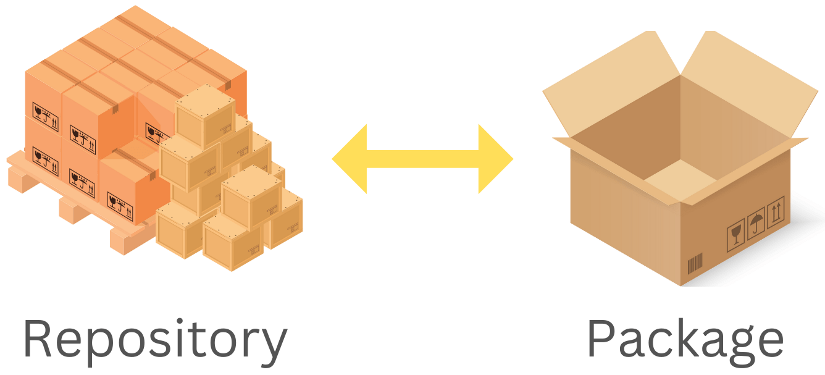FUNDAMENTALS A Complete Guide for Beginners

As an open-source operating system, Linux provides various software tools and applications to users. One of the essential elements of the Linux ecosystem is the idea of software repositories. Software packages are reserved in repositories which are centralized zones where the packages can be kept, manipulated, and distributed. In this article, you’ll explore what a repository is and how it works in Linux.
What is Repository in Linux?
A repository is a collection of packages in Linux just like a warehouse full of goods. Package managers use repositories to search and download software packages. When a user attempts to install a new software package, the package manager searches through the configured repositories of the operating system to locate the requested package.
What is a Package Manager?
A package manager is a software tool that simplifies installing, updating, configuring and removing software packages on a system. Package managers are commonly used in operating systems such as Linux, macOS, and Windows.
There are several package managers available in Linux, such as:
- APT (Advanced Package Tool)
- YUM (Yellowdog Updater Modified)
- DNF (Dandified YUM)
- Pacman
- Zypper
- Portage
- Snap
How Does Repository Work in Linux?
Linux users generally use a package manager to discover and install new software packages. Afterward, the package manager checks the system’s configured repositories to find the requested package. Once the package manager finds the package in a repository, it retrieves the required files and installs the package on the user’s system.
Repositories hold essential information regarding the available packages, such as the package name, version, dependencies, and other metadata the system needs. Based on this information, the package manager determines which packages to install, which dependencies to resolve, and which packages are required to update.
Types of Repositories
Various types of software repositories are used in Linux-based operating systems. Here are some useful types:
1. Official Repositories
Operating system vendors provide these repositories, including Ubuntu’s “main” and “universe” repositories, or CentOS’s “base” and “updates” repositories, among others. The vendor has tested and validated the packages held in these repositories.
2. Third-Party Repositories
Third-party repositories are supplied by developers or vendors and may contain software packages that are not available in the official repositories. Some examples of third-party repositories are the ‘PPA’ repositories for Ubuntu or the ‘EPEL’ repository for CentOS.
3. Community Repositories
Community-maintained repositories are available and may hold packages that are not found in official or third-party repositories. Community repositories such as the Arch User Repository (AUR) for Arch Linux or the Fedora Copr repository are worth noting.
4. Local Repositories
A local server or network hosts these repositories. Organizations and networks can use local repositories to distribute custom software packages or updates.
5. Snapshot Repositories
Repositories that contain specific versions of software packages are designed for testing or development purposes. The repositories frequently update as new package versions become available.
Depending on the Linux distribution and package manager, the specific types of repositories available may differ. To avoid security risks, it is critical to add only repositories from trustworthy sources.
Use of Repositories in Linux
Repositories are essential in Linux for several reasons.
A. Quick & Easy Access
By providing a centralized repository, Linux ensures that users have quick and easy access to the software packages they need, eliminating the need to search for packages on third-party websites or download them manually. Using repositories in Linux relieves the risks associated with downloading software from untrusted sources, as it provides a trusted and verified source for packages.
B. Ensures Security
Repositories ensure that software packages are up-to-date and secured. The use of repositories in Linux simplifies the process of updating software packages, as package maintainers can release updates easily, which users can then install using a simple command. This helps to minimize the risk of security vulnerabilities and secures system stability.
C. Collaboration
Repositories help the Linux community to collaborate and share resources. Developers may share and work together on open-source projects using repositories, making it simple for others to contribute to and build upon their work. This promotes creativity and the creation of high-caliber software packages that can help the entire community.
Conclusion
In conclusion, a repository in Linux is a central location for software packages. For locating, downloading, and upgrading software packages on a Linux system, repositories are essential. They encourage teamwork, guarantee stability and security, and make it simple for users to locate and install the packages they require. Linux users can benefit from the many advantages of open-source software development and make sure that their system is running the most recent and secure software packages by using repositories.




